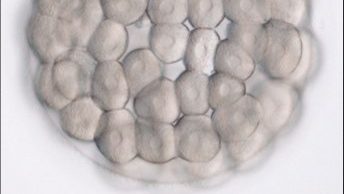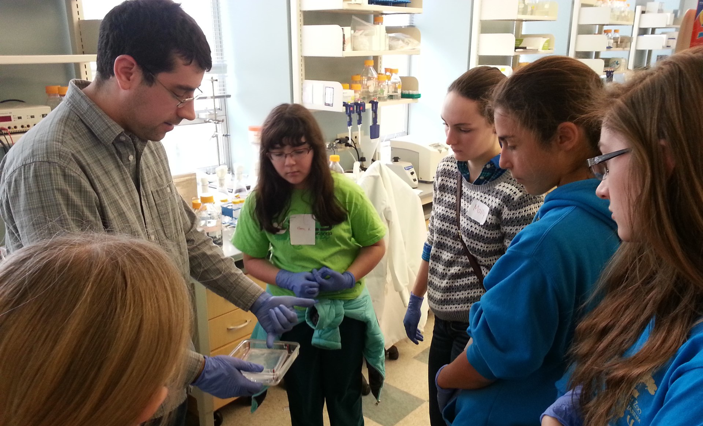
Scientific Enquiry using Ocean Life
Saturday morning in the lab with K-2 scientists in training:
We welcomed several elementary school students (grades K-2) to the lab on a recent Saturday morning for an activity coordinated through the CMU Gelfand Center. The students spent the morning exploring a variety of different invertebrate marine creatures – everything from corals to crabs and, of course, starfish! The students used scientific methods to begin to address basic questions that help us understand about life in the ocean.
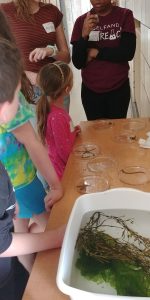
Budding Taxonomists
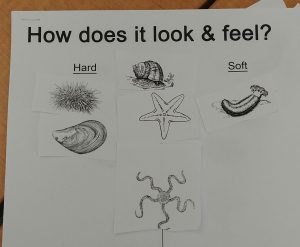 Students observed the marine animals in our tanks and made observations about each. For example: Is the animal hard or soft? Which animals have eyes? How about legs? Based on their observations, students were then asked to group animals together based on shared characteristics. This is the first step to develop a taxonomy that scientists use to understand evolutionary relationships among animals
Students observed the marine animals in our tanks and made observations about each. For example: Is the animal hard or soft? Which animals have eyes? How about legs? Based on their observations, students were then asked to group animals together based on shared characteristics. This is the first step to develop a taxonomy that scientists use to understand evolutionary relationships among animals
Developing and testing Hypotheses
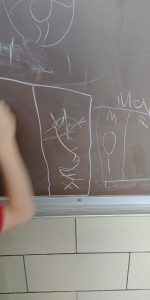
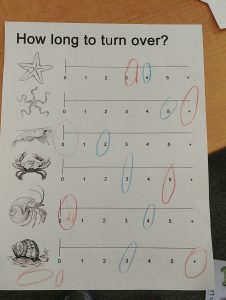 How long will it take to turn over?
How long will it take to turn over?
We observed the animals and thought about how they move: which body parts do they use, how fast are they, what ways can they move?. Following these careful observations, they charted their prediction of how long they would take to turn over and then tested their hypotheses. They then graphed predicted versus experimental results.
Did you know that many marine animals have a larval stage?
What do you think a larval sea star looks like? We used the microscope to take a look and draw what we saw.

This event was designed by Greg Cary and Veronica Hinman (Biological Sciences); coordinated by Pamela Piskurich (CMU Gelfand Center); with assistance from Carolyn Ku and Allison Meyer (Biological Sciences), and Stephanie Blackwood and Abriana Stewart Height (Gelfand). Financial support provided by the NSF.

CMU lab hosts a “Tour Your Future” event with the Carnegie Science Center
Twelve middle and high school aged girls spent their Saturday morning visiting Biology Laboratories at the Mellon Institute. A “Tour Your Future” event, run through the Carnegie Science Center, Girls Math and Science partnership, provides girls with opportunities to experience first hand the working life of women in STEM careers.
The girls visited the Mellon Institute’s Marine Aquaria Facility where they had a chance to get their hands wet and get “eye to spine” with some of the echinoderms housed there. They were able to get the animals to spawn to produce gametes and the highlight of the tour was using the microscope to watch eggs and sperm meet to make embryos. They also had a chance to try some molecular biology and to look at florescent DNA on agarose gels.
This event was organized by Nina Barbuto (Carnegie Science Center); Adam Foote, Sowyma Yennan, and Veronica Hinman (Biological Sciences).
Diversity in the Ocean
Many people are fascinated by life in the ocean and wonder what it might be like to be a marine biologist. This general interest provides a great opportunity to engage students in biological research. Using marine taxa as an instructional tool, our “Diversity in the Ocean” outreach program provides a curricular extension for 10th to 12th grade biology students to an enhance their understanding of (i) animal diversity and how it arises (both in development and evolution), of (ii) how molecular biology can be used to study animal diversity, and (iii) how studies in biology can intersect with other disciplines, in particular computer science. It’s our overall goal to excite students about biology and to provide experiences not usually available to a Pittsburgh high school student. We also want students considering careers in biology to appreciate the breadth of traditional disciplines and techniques that might be used to study biological questions.
In the Department of Biological Sciences
The students start this unit by making a day trip to the labs here in the department. They get to examine marine taxa from a great diversity of animal phyla which we obtain from the Marine Biology Lab at Woods Hole and maintain in our in-house marine aquaria facility. There are approximately 35 animal phyla, yet most people are only familiar with a handful – usually the chordates, terrestrial arthropods and mollusks. The experience in our labs therefore represents an almost unique experience for many Pittsburgh students to examine animals from phyla as, Porifera, Nemertea, Platyhelminthes, Ctenophora, and some oddities such as the Pycnogonids. The students get to carefully handle and observe live specimens and to use some keys to classify these animal to their correct phylum. Some of these organisms are planktonic so that students also get to see the life history diversity of marine animals. The students use the microscopes in the lab to examine the specimens closely and to photograph them. We then collect small amounts of tissue for DNA extractions.
The students then move to the molecular biology labs and perform DNA extraction and PCR using primers to amplify 18s ribosomal DNA. Finally they get to load some pre-prepared PCR products for gel electrophoresis. PCRs are completed after the students leave and are purified and sent for sequencing. The students therefore get a chance to experience working in a molecular biology lab and to learn some basic molecular biology techniques.
The students then move to the microscope lab to observe animal development. They get to handle live sea urchin eggs and sperm and to observe fertilization under a microscope. The very dynamic process of fertilization envelope rising demonstrates egg sperm recognition which is an important mechanism for speciation in the ocean. The students also get a chance to look at live sea embryos in cell cleavage, blastula, gastrulae stages and also, if available, some later larval forms including metamorphosed juveniles. The students photograph and print and annotate these pictures.
At the high school
Once the sequences are in, the group from CMU goes out to the school for a computer lab. We help the students match the DNA sequence to the specimen and use Blast searches through NCBI to identify the sequences. The data are used in basic phylogenetics to make a tree of life for these specimens in a class exercise. The students can also use links from pubmed to find out more about the animal species identified through blast. The phylogenetics exercise provides an opportunity to discuss evolutionary theories about why some sequences are more similar to others and why this can be used to group animals into taxonomic groups. We also discuss how the enormous amount of sequence data can be used and some current questions in genomics.
This units is taught by graduate and undergraduate students from the Biology Department and therefore also provides a teaching experience for our students. We additionally make time for the high school and CMU students to talk about career paths in biology.
This outreach program is supported by NSF.
